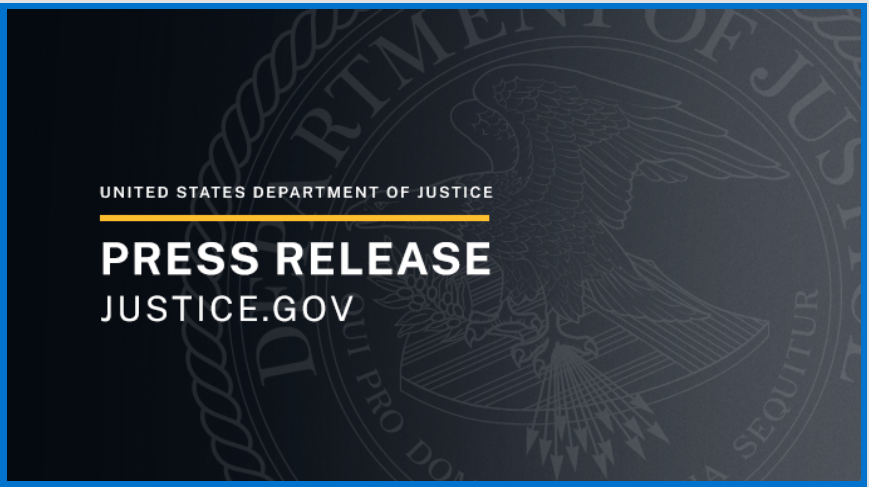[ad_1]
Remarks as Prepared for Delivery, “‘That’s What F/RANDs Are For’ and Antitrust Implications When They’re Gone”
Thank you for that kind introduction and thanks to Concurrences for inviting me to speak at what has become a traditional event adjacent to Fordham’s Annual Conference on International Antitrust Law and Policy. It’s a pleasure to be here with antitrust friends from both the U.S. and around the world to discuss antitrust developments. I also want to thank my colleague, Alice Wang, for her help in drafting today’s remarks.
At the Antitrust Division, we have been thinking a lot about innovation. Earlier this year, President Trump outlined a vision for the “Golden Age of American Innovation.”[1] As the President aptly recognized, “Scientific progress and technological innovation were the twin engines that powered the American century.”[2] Today, policies that promote rather than hinder innovation are more important than ever.
As you may have seen on social media, this week is “Innovation Week” at the Antitrust Division, and we’re celebrating it the nerdy antitrust way through a series of speeches. Assistant Attorney General Gail Slater gave two speeches focusing on innovation, at the Georgetown conference two days ago[3] and this morning at Fordham,[4] and my fellow Deputy Assistant Attorney General Omeed Assefi gave a talk at Cardozo Law School on Tuesday that highlighted our innovative antitrust rewards program.
Competition and innovation are effectively synonymous since competition occurs through both price and non-price channels like innovation. Innovation drives technological progress, generates better quality products, and propels our economy forward. Today, I want to talk about the intersection of two legal frameworks that promote innovation: antitrust and intellectual property (IP).
It has been long recognized that antitrust and IP are aligned and complementary. Antitrust, of course, is the law of competition. Non-price competition, including through quality and innovation, is core to the competitive process and commands solutions. Competition is invigorated by innovative solutions that lead to a wide range of products, services, and solutions. Antitrust law and IP law are thus united in the common goal of fostering innovation (also known sometimes as “dynamic competition”). In addition, IP protection is key to securing mavericks’ ability to enter markets and challenge entrenched incumbents to the benefit of consumers.
Standards development is perhaps the epitome of where antitrust and IP considerations intersect. Collaborative industry standards have generally been recognized as procompetitive — they promote interoperability, health and safety, and innovation. Participants pool their innovative solutions together, often developing new solutions as part of the standards development process. Recognizing the procompetitive attributes of standards development, Congress enacted the Standards Development Organization Advancement Act (SDOAA) in 2004, providing an exemption from per se antitrust liability and treble damages for a “standards development organization” (SDO) while engaged in a “standards development activity” as defined in the statute.[5]
Collaborative standards development assured by contractual F/RAND commitments has been enormously successful, generating great benefits for consumers. These commitments mean that a patent holder has pledged that it will license patents that are or may become essential to implementation of a standard (known as standards essential patents or “SEPs”) on a reasonable and non-discriminatory (RAND) or on a fair, reasonable, and non-discriminatory (FRAND) basis.[6] The development of industry standards, assured by F/RAND commitments, has fueled tremendous innovation in areas like wireless connectivity and video coding. We now all take for granted that we can stream a movie on a small device while sitting on an airplane moving through the sky, but we shouldn’t. All sorts of innovative technologies have been enabled by voluntary F/RAND licensing — all for low costs that have been decreasing year over year. That’s how you can buy a smartphone today, packed with all types of features and functionality, for just $50.
For many years, antitrust enforcers focused on unilateral conduct related to F/RAND assurances, like hold-up and hold-out. For a time, there was a skewed focus on hold-up — a theory endorsed by Big Tech incumbents — under which a patent holder leverages a technology’s inclusion in a standard to demand supracompetitive royalties. That skewed approach was corrected during the first Trump administration, when the Antitrust Division was led by AAG Makan Delrahim, who correctly recognized that “implementer hold-out poses a more serious threat to innovation than innovator hold-up” and advocated acting to prevent hold-out.[7] More recently, the Division’s leadership under the last administration highlighted that anticompetitive conduct can be undertaken by any party, implementer or patent holder, and that a case-by-case approach to scenarios involving standards essential patents is the right approach.[8] I agree with both propositions. Implementer hold-out indeed poses a greater threat to innovation than innovator hold-up, especially since patents are not self-executing rights, so a neutral court determination is always required in order for injunctions to issue. And a case-by-case assessment is indeed the right approach.
Today, I would like to zoom in on two scenarios related to standards development that have received less attention: (1) collaborative industry standards that are not F/RAND assured, and (2) organizations that develop closed, proprietary standards that integrate patented technologies and encourage infringement.
Collaborative Industry Standards That Are Not F/RAND Assured
For years, antitrust enforcers have recognized that F/RAND commitments by essential patent holders serve as safety valves so that in cases where such patents confer market power — which is assessed on a case-by-case basis — the commitments help prevent the exercise of such market power.[9] At the Antitrust Division, we are concerned about scenarios where there is a breakdown of the FRAND-assured standards development ecosystem.
A. When F/RAND assurances are negative or missing
The first scenario is when supposedly “open” standards are adopted by SDOs despite the lack of F/RAND assurances or even the existence of “negative” F/RAND declarations submitted on them — in other words, when the technology contributor has affirmatively declined to license its patents on F/RAND terms.
F/RAND commitments are voluntary in nature. SDO patent policies typically require owners of patents that are or may become essential to a standard to indicate whether or not they intend to make them available on F/RAND terms. The rationale behind such policies is that, where patent holders declare that they will not offer F/RAND terms (a scenario that has been very rare), or where they decline to submit a F/RAND form indicating their intentions, the SDO would ensure that these proprietary technologies are not included in the standard.
Standards that are rife with missing or negative F/RAND declarations create a concerning opportunity for exclusion because access to the standard, let alone on reasonable competitive terms and conditions, is not assured. When industry standards that are supposed to be open nevertheless incorporate technologies that the patent owner indicated it will refuse to license on F/RAND terms, implementers of that standard cannot use the standard without infringing on essential patents the access to which is not F/RAND assured. This creates considerable competitive risks because of the possibility that, after the standard is adopted and commercially successful, its implementers would be “locked in” to inherently infringing technology, the access to which is not assured on competitive F/RAND terms. As a result, essential patent holders would be able to legitimately charge implementers whatever terms of conditions they deem fit or, worse yet, legitimately exclude implementers (including their competitors) from the marketplace through injunctions. In addition to outright exclusion, such dynamics may lead concerned companies to hesitate to adopt the standards, thus stalling market innovation. Other ramifications may include the need to reopen adopted standards to avoid certain patents, which would lead to huge inefficiencies and waste of significant work that went into standards development.
Importantly, the same problems apply to missing F/RAND assurances. Antitrust enforcers have not often taken into account scenarios in collaborative standards development when F/RAND commitments are broadly missing. Similar to negative F/RAND declarations, these situations create competitive risk, because there is no clarity around the future licensing terms and patent owners could later legitimately demand excessive licensing fees after a standard becomes widely adopted or exclude future implementers. The cost to innovation of these problems is high, and it is a significant problem that we need to think about how to address.
B. When proprietary standards development policies are not F/RAND-based
A second scenario is when proprietary standards development consortia policies are not F/RAND-based.
Federal policy like the SDOAA and the OMB Circular A-119, “Federal Participation in the Development and Use of Voluntary Consensus Standards and in Conformity Assessment Activities,” recognize the importance and procompetitive benefits of open collaborative standards development that meets certain safeguards like openness, balance of interests, due process, appeals process, and consensus.[10] In contrast, there have long been concerns about closed proprietary standards, especially when they are used by dominant players to entrench their market position.
Proprietary consortia, SDOs, or other standards development arrangements that do not have IP rights policies that meet the SDOAA and OMB Circular A-119 standards can raise competitive concerns. Under the OMB Circular A-119, in order to qualify as a “voluntary consensus standard,” standards that include patented technology must be governed by IP rights policies that include “clear rules” and that “take into account the interests of all stakeholders, including the IPR holders and those seeking to implement the standard.”[11] Where proprietary consortia or other collaborative development arrangements fail to be balanced and fairly reflect the interests of all stakeholders and are instead biased in favor of one set of interests, there is cause for antitrust concern.
For example, there are private consortia that impose mandatory, royalty-free cross-licensing obligations on their members. Essentially, these consortia require that all members pool their IP together and allow all other members to cross-license their IP for free. Sometimes, they do so with the express purpose of creating a purportedly royalty-free standard, and they tout the benefits of such royalty-free standards.
Pooling or cross-licensing arrangements can have procompetitive characteristics. But in the context of a proprietary consortium that is made up of dominant implementers that collectively possess market power, such arrangements can be competitively harmful.[12]
In the example of the private consortium that imposes mandatory, royalty-free cross-licensing, that policy allows a group of dominant implementers to fix the price of royalties at zero. The cadre of dominant implementers can then push for the adoption of this closed standard by adopting the standard themselves. Once the standard becomes widely adopted, companies that need to use the standard are forced to license their patented technologies for free. In such cases, these royalty-free cross-licensing requirements can effectively operate as collusive schemes among dominant players to promote closed, proprietary standards. Importantly, this has the effect of stifling innovation. If adequate royalties reflecting the value of a technology cannot be earned, the incentives for companies to invest in R&D are diminished and, as a result, we can expect market innovation to suffer.[13] Moreover, over time, successful proprietary standards may push out other truly open standards that would better support interoperability and innovation.
We would be particularly concerned where developers of standards, either open or closed, misrepresent their standard as available under F/RAND terms to promote market adoption when that claim is not true because its development was in fact not carried out under a F/RAND IP policy, or because of negative or missing F/RAND declarations, as discussed earlier. This is a misrepresentation of material information to the marketplace ex post after a standards development process has already concluded, and it is a cause for competitive concern that warrants close watch.
Proprietary Standards That Incorporate Patented Technology for Infringement
Finally, I’d like to talk a little bit about the recent Antitrust Division and U.S. Patent and Trademark Office (PTO) joint statement of interest in the Radian v. Samsung case.[14]
In that case, the plaintiff, Radian Memory Systems, filed a complaint for patent infringement against Samsung Electronics and moved for a preliminary injunction. According to Radian, it had developed and patented an innovative technology that improves the management of flash solid-state drives (SSDs), particularly in enterprise and data-center operations.[15] Radian alleged that initially, it was pressured by Samsung and other members of a private consortium to join that consortium.[16] Radian refused to join, because the consortium had an IP rights policy requiring mandatory, royalty-free cross-licenses.[17] That policy would have required Radian to give its patented technology to the members of the consortium — which included Radian’s competitors and customers — for free.
After it refused to join the consortium, Radian alleged, the consortium incorporated its patented technology into the proprietary standard anyway, using information gained from confidential discussions and evaluations with Radian during conferences and product demonstrations.[18] At the same time, Radian alleged that it was excluded by the consortium from meetings and the standards development process, which made it more difficult for Radian to detect infringement of its patents.[19] Radian alleged that it only found out that key aspects of its technology had been incorporated when the consortium’s standard was published.[20]
The Antitrust Division and the PTO’s statement of interest explained that there is serious potential for anticompetitive harm in standards development processes that are dominated by large firms who are implementers of the technology in the standard.[21] These competitive concerns are particularly acute when these dominant implementers can exercise market power.[22] As the statement of interest noted, this dynamic involving dominant implementers with collective market power may evoke monopsony concerns under the antitrust laws.[23] Radian’s story illustrates the ongoing concerns with proprietary standards development processes, and especially the antitrust implications of such processes.
We at the Antitrust Division will continue to remain vigilant about competitive issues that arise at the interface of antitrust and intellectual property, including those involving standards development processes. Competition and innovation drive the U.S. economy and greatly benefit American consumers — it is our mission to ensure that they are alive and well. As President Trump put it: “Surely, there will be challenges on the path ahead, but together, we’ll meet them and transcend them all . . . . [W]e do not shrink from the future or cower at the face of uncertainty. We dominate the future. We conquer new frontiers.”[24] In following these inspiring words, I look forward to conquering new antitrust and innovation frontiers together with my colleagues.
Thank you.
[1] The White House, A Letter to Michael Kratsios, Director of the White House Office of Science and Technology Policy (Mar. 26, 2025), https://www.whitehouse.gov/briefings-statements/2025/03/a-letter-to-michael-kratsios-director-of-the-white-house-office-of-science-and-technology-policy; see also The White House, ICYMI: President Trump Outlines OSTP’s Goals and Priorities (Mar. 27, 2025), https://www.whitehouse.gov/articles/2025/03/icymi-president-trump-outlines-ostps-goals-and-priorities.
[3] Press Release, US Dep’t of Justice, Assistant Attorney General Gail Slater Delivers Keynote Address at the 2025 Georgetown Law Global Antitrust Enforcement Symposium (Sept. 16, 2025), https://www.justice.gov/opa/speech/assistant-attorney-general-gail-slater-delivers-keynote-address-2025-georgetown-law.
[4] Press Release, US Dep’t of Justice, Assistant Attorney General Gail Slater Delivers Keynote Remarks at 52nd Annual Conference on International Antitrust Law and Policy (Sept. 18, 2025).
[5] See 15 U.S.C. § 4302.
[6] In referring to these contractual commitments, some SDOs’ IP policies use the term Fair, Reasonable, and Non-Discriminatory (FRAND), while others utilize the term Reasonable and Non-Discriminatory (RAND). The exact meaning of FRAND or RAND is determined by the specific SDO’s IP policy. For ease of reference, I will refer to all of these, collectively, as F/RAND commitments or F/RAND assurances.
[7] Makan Delrahim, Assistant Att’y Gen., Antitrust Div., US Dep’t of Justice, The “New Madison” Approach to Antitrust and Intellectual Property Law (Mar. 16, 2018), https://www.justice.gov/archives/opa/speech/file/1044316/dl?inline=.
[8] Press Release, US Dep’t of Justice, Justice Department, U.S. Patent and Trademark Office and National Institute of Standards and Technology Withdraw 2019 Standards-Essential Patents (SEP) Policy Statement (June 8, 2022), https://www.justice.gov/archives/opa/pr/justice-department-us-patent-and-trademark-office-and-national-institute-standards-and (‘The Antitrust Division will carefully scrutinize opportunistic conduct by any market player that threatens to stifle competition in violation of the law…” said Assistant Attorney General Jonathan Kanter of the Justice Department’s Antitrust Division. “I am hopeful our case-by-case approach will encourage good-faith efforts to reach F/RAND licenses and create consistency for antitrust enforcement policy so that competition may flourish in this important sector of the U.S. economy.’).
[9] See, e.g., US Dep’t of Justice & Fed. Trade Comm’n, Antitrust Enforcement and Intellectual Property Rights: Promoting Innovation and Competition 46-48 (2007), https://www.justice.gov/file/614651/dl?inline.
[10] See Off. of Mgmt. & Budget, Exec. Off. of the President, Final Revision of OMB Circular No. A-119 at 16 (Jan. 2016), https://www.nist.gov/system/files/revised_circular_a-119_as_of_01-22-2016.pdf (OMB Circular A-119).
[12] See US Dep’t of Justice & Fed. Trade Comm’n, Antitrust Guidelines for the Licensing of Intellectual Property § 5.5 (2017), https://www.justice.gov/atr/IPguidelines/dl ([E]xclusion from cross-licensing and pooling arrangements among parties that collectively possess market power may, under some circumstances, harm competition.).
[13] See US Dep’t of Justice & Fed. Trade Comm’n, Antitrust Enforcement and Intellectual Property Rights: Promoting Innovation and Competition 58 (2007), https://www.justice.gov/file/614651/dl?inline (foreclosure of innovation” is a potential anticompetitive effect of cross-licensing and patent-pooling agreements).
[14] Statement of Interest of the United States, Radian Memory Sys. LLC v. Samsung Electronics Co., LTD., No. 2:24-cv-1073 (E.D. Tex. June 24, 2025), https://www.justice.gov/atr/media/1404506/dl?inline.
[18] Complaint ¶¶ 12, 228-239, Radian Memory Sys. LLC v. Samsung Electronics Co., LTD., No. 2:24-cv-1073 (E.D. Tex. Dec. 24, 2024).
[19] Plaintiffs’ Motion for Preliminary Injunction at 2, Radian Memory Sys. LLC v. Samsung Electronics Co., LTD., No. 2:24-cv-1073 (E.D. Tex. May 6, 2025).
[21] Statement of Interest of the United States at 2, Radian Memory Sys. LLC v. Samsung Electronics Co., LTD., No. 2:24-cv-1073 (E.D. Tex. June 24, 2025), https://www.justice.gov/atr/media/1404506/dl?inline.
[23] Id.; see also Statement of Interest of the United States, Global Music Rights, LLC v. Radio Music License Committee, Inc., No. 2:16-cv-9051 (C.D. Cal. Dec. 5, 2019).
[24] The White House, President Trump Delivers Remarks and Signs Executive Orders at AI Summit, YouTube (July 23, 2025), 25:38-26:09, https://www.youtube.com/watch?v=tBNX9x5GgPE.
[ad_2]



